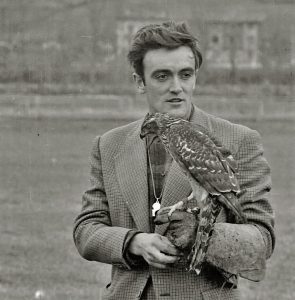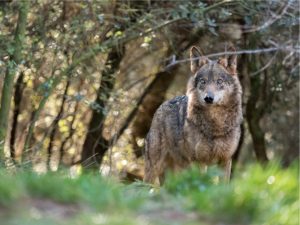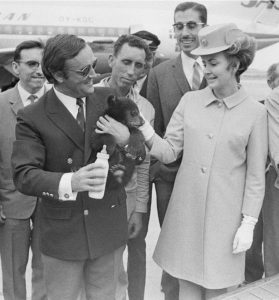In Spain, the name Félix inevitably brings to mind a man whose surname need not be added. In the 14 years of his career as a broadcaster of nature documentaries, Félix Rodríguez de la Fuente (14 March 1928 – 14 March 1980) became a key figure in the birth of an environmental awareness that transcended borders. On a par with Britain’s David Attenborough or France’s Jacques Cousteau, his impact was so profound that, since his untimely death in a plane crash, no one has been able to match the greatness of his charismatic personality. Among Spaniards, he pioneered a way of understanding the relationship between man and the planet that we now describe in one word: sustainability.

The public Félix, the figure who became a celebrity and an idol for millions of children, began to emerge in 1964, when his triumph in a falconry competition made him a guest on a Spanish television programme. He entered the studio with a falcon perched on the gauntlet covering his fist. It is said that viewers were so fascinated by his magnetism and talent for sharing his passion that the channel received a flood of letters asking for him to return, and he soon became a regular presenter on the programme Fin de semana.
From medicine to nature
But before the star was born, Félix was already an established professional with a hobby outside his original occupation. Born in 1928 in a rural Castilian village (Poza de la Sal, Burgos), the son of a notary public, he was fascinated by the nature that surrounded him from an early age, but he had to follow the traditional family path. He graduated in medicine and specialised in dentistry, a profession he left shortly after his father’s death to embrace his passion for nature, especially falconry, a practice that had been abandoned in Spain and which he had recovered from medieval sources.

In 1961 he founded a falconry centre and was called in as a consultant for Anthony Mann’s blockbuster El Cid, filmed in Spain with Charlton Heston and Sophia Loren. Shortly after, he published his first books and presented his studies on the peregrine falcon in Spain, which earned him prestige in the European ornithological community. The Franco government commissioned him to capture two falcons for the King of Saudi Arabia, who in return financed the production of his first documentary, Señores del espacio [Lords of Space] (1966).
From then on, his collaborations with radio and the press proliferated, as did his work in the form of field notebooks and encyclopaedias, translated into 14 languages, and, above all, the television career that made him famous: series such as Fauna and Planeta Azul [Blue Planet], but especially the 124 episodes of El hombre y la Tierra [Man and the Earth] (1973-80), divided into three parts: Iberia, South America and North America. There were no written scripts or story boards; all his monologues and narrations were improvised and came directly from his impeccable oratory. Félix’s programmes have been broadcast in more than 40 countries to an audience of 800 million.
Beyond television
But he was not just a television star. Away from the limelight, he left an immense environmental legacy: co-founder of the Spanish Ornithological Society, founder and vice-president of the Spanish branch of the World Wildlife Fund (WWF), promoter of the first Spanish laws on nature conservation and the protection of endangered species such as birds of prey, the wolf and the Iberian lynx. At a time when development was ruthlessly trampling on nature, his opposition to an urbanisation plan for the Doñana marshes was a key factor in the initiative led by biologist José Antonio Valverde to ensure that this precious wetland acquired the status that protects it today. Félix criticised the “throw-away society” at a time when no one was even aware of the problem. And he left behind a whole generation of young collaborators who have gone on to become leading figures in Spanish ecology, such as Miguel Delibes de Castro, Javier Castroviejo, Joaquín Araújo and others.
![BBVA-OpenMind-Yanes-Felix Rodriguez de la Fuente conciencia ambiental de un pais_Series such as Fauna and Planeta Azul [Blue Planet], but especially the 124 episodes of El hombre y la Tierra [Man and the Earth] (1973-80) have been broadcast in more than 40 countries to an audience of 800 million. Credit: El hombre y la tierra © RTVE.](https://www.bbvaopenmind.com/wp-content/uploads/2024/03/BBVA-OpenMind-Yanes-Felix-Rodriguez-de-la-Fuente-conciencia-ambiental-de-un-pais_3-300x203.jpg)
In 1980 he went to Alaska to film a dog sled race for El hombre y la Tierra. On 14 March, his 52nd birthday, he boarded a light aircraft with collaborators Teodoro Roa and Alberto Mariano Huéscar, with pilot Warren “Ace” Dobson at the controls. Before boarding, he is reported to have commented: “What a beautiful place to die.” Shortly afterwards, the plane crashed, killing everyone on board.
The figure of Félix has not been immune to criticism among others for the use of scenographic tricks in his documentaries and habituated animals accustomed to the presence of humans, a common practice at the time. There has also been no shortage of speculation about his death. But while no brilliant figure is without shadows, his light outshines any darkness.

According to his daughter Odile, the youngest of his three children with his wife and collaborator Marcelle Parmentier, and the main heir to his work, Félix would shake his head today at the severity of climate change and the scarcity of public outreach about nature. One of his biographers, Benigno Varillas, noted that Felix’s ambition was to recover the harmonious relationship with his environment that Palaeolithic humans had, a sustainable consumption of resources in communion with nature.
Comments on this publication